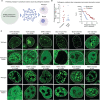This is a preprint.
Protein codes promote selective subcellular compartmentalization
- PMID: 38659952
- PMCID: PMC11042338
- DOI: 10.1101/2024.04.15.589616
Protein codes promote selective subcellular compartmentalization
Update in
-
Protein codes promote selective subcellular compartmentalization.Science. 2025 Mar 7;387(6738):1095-1101. doi: 10.1126/science.adq2634. Epub 2025 Feb 6. Science. 2025. PMID: 39913643
Abstract
Cells have evolved mechanisms to distribute ~10 billion protein molecules to subcellular compartments where diverse proteins involved in shared functions must efficiently assemble. Here, we demonstrate that proteins with shared functions share amino acid sequence codes that guide them to compartment destinations. A protein language model, ProtGPS, was developed that predicts with high performance the compartment localization of human proteins excluded from the training set. ProtGPS successfully guided generation of novel protein sequences that selectively assemble in targeted subcellular compartments. ProtGPS also identified pathological mutations that change this code and lead to altered subcellular localization of proteins. Our results indicate that protein sequences contain not only a folding code, but also a previously unrecognized code governing their distribution in specific cellular compartments.
Conflict of interest statement
Competing Interests: R.A.Y. is a founder and shareholder of Syros Pharmaceuticals, Camp4 Therapeutics, Omega Therapeutics, Dewpoint Therapeutics and Paratus Sciences, and has consulting or advisory roles at Precede Biosciences and Novo Nordisk. R.B. has consulting or advisory roles at Dewpoint Therapeutics, J&J, Amgen, Outcomes4Me, Immunai and Firmenich. H.R.K. is a consultant of Dewpoint Therapeutics. I.C. is a consultant of Paratus Sciences. The remaining authors declare no competing interests.
Figures



References
Publication types
Grants and funding
LinkOut - more resources
Full Text Sources
